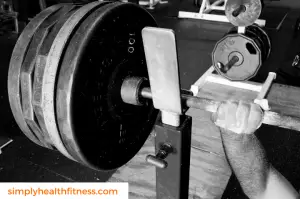
How much should you be able to bench press? More, of course!
With that said, it’s great to figure out what level you’re at and keep an eye on your results.
Not only does it motivate you to improve, but it helps decide how to train the bench press based on your experience and strengths. Good weight training plans rely on knowing where you are in your strength journey.
Today we’re going to cover the most important topics:
- How much weight should you be able to bench (for one rep)?
- How do we measure bench press strength level?
- How should you train to improve your bench press?
So let’s start with the strength level of the average man or woman and how you stack up…
Average Bench Press for Men
The average man in the US is 5’9″ (175cm) and just under 180lbs. This is the standard for our average bench press, and it’s important to keep those in mind – strength standards need to keep your body weight in mind.
A 50kg and 150kg man have a drastically different body type. They are going to have different limb lengths and strength levels. More importantly, bigger guys will have a “fast track” rate of progress since they can add more mass and faster.
The average man is likely to have a one rep max somewhere in the 50 to 85kg region (without any direct training experience).
This depends entirely on things like body weight, athletic experience, and genetics – which is why it’s a range. It’s unlikely for an untrained man to bench press into the 3 digits (an intermediate level bench) but does happen in some people with intense physical jobs (like construction).
Bench press standards for men will then improve from there, based on an average body weight.
These standards also change by age, as we get older these standards change – and we generally suggest taking off 10% for every decade after the 20s.
So, for example, a 35-year-old man’s strength would become “proficient” around 105kg, rather than the 116kg outlined above. Meanwhile, a 45-year-old man would become proficient around 95-100kg.
These all depend on how you age which is all about how you’re training, eating, and taking care of yourself. A decade isn’t the same for everyone!
Average Bench Press for Women
The average woman in the UK is 5’4″ and 170lbs (77kg). Men tend to be stronger on bench than women due to differences in hormones and the different fitness goals and physiques of men and women. However, the process and practice should be the same for both sexes.
The bench press average for untrained women is usually somewhere between 25 and 40kg. Again, this varies by genetics and experience, but provides a basic range for ‘normal’ strength levels.
Extremely physical jobs can lead to higher results, while a more-inactive life will lead to lower strength even before starting their fitness journey.
Bench press standards increase with bigger jumps at the start and smaller differences as experience and strength levels increase:
Just like the men’s standards, these can be used as a basis for standards as we age. This standard applies to those in their 20s, and every decade of age afterwards, we subtract 10% from each category to reflect the loss of upper body strength as we age due to reduced muscular efficiency and protein turnover.
E.g. – a 35-year-old woman would become advanced at 75kg, rather than 83kg, at the same bodyweight.
How to assess your current bench press strength
There are a few ways to test your bench press strength and get a better idea of “how much ya bench”.
1 rep max (1RM)
The most common way of testing strength is a single, max-effort rep for weight. This is called the 1-rep-max because it’s the maximum weight possible for that number of reps. We also use other tests like 2-, 3-, and 5-rep-maxes to test strength sometimes.
1RMs are great because they can tell us exactly what you can do and show up some of the weaknesses in your lifting. For example, what causes you to fail at these heavy weights? It can be useful to keep track of your sticking points and direct your future workouts towards fixing them.
While they are less popular, there are also a wide range of other tests that you might use to figure out your strength:
Max reps
The NFL combine method of performing the maximum number of reps at a given weight (100kg or 225lbs) tests your muscular endurance and strength-endurance. A rep max test is better for slow-twitch trainees, however, and may not provide the most accurate view of strength.
Max velocity
If you have the equipment you can test bar speed at a certain % of your best bench press. For example, two people may have different bar-velocity at 70% of their 1-rep max and this shows us what power is being produced.
Timed pressing
This involves pressing to a metronome or beep track and – like max reps – tests muscular endurance and strength-endurance. These are often used to mimic the press-up tests in military and public service testing.
You can perform many of these tests at home or at the gym. However, you want to make sure that – when performing a 1-rep-max test – you either have a spotter or you’re using a high-quality bench for home gym that includes spotting arms – or in a squat rack / power cage.
The last thing you want is to get pinned under a heavy one rep max!
How to improve your bench press strength
Building strength and muscle relies on a real quality set of habits when lifting, in the kitchen, and in bed.
Smart Strength Training
First of all, you need to prioritize the basic principles of good strength training:
- Overload: you have to continually stress yourself with heavier weight, more reps, or a greater total work-load within a week.
- Specificity: you need to make sure you’re training the movement to lift more weight in that movement. You can use other exercises to build mass and strength, but bench pressing is a skill that needs practice.
- Loading change: don’t always go heavy – make sure that you’re taking time to recover between heavy workouts so that they’re more effective and you can get the most out of them.
- Frequency: bench responds well to regular practice, and you can use 2-3 sessions per week to get stronger. If you don’t train it regularly, it won’t progress as well. (Only increase frequency when you have more weightlifting experience to avoid injury!)
- Technique: lifting heavy weights means using proper technique to reduce injury risk. Put time into practicing proper form with lighter weights!
These should produce a simple workout routine that fluctuates between heavy and light and offers proper time for both recovery and technical practice. It offers a system of training that works reliably for everyone from beginner to elite athlete!
High-Quality Nutrition
You’re also relying on good nutrition to build strength and support the muscular and connective tissues needed to lift big weights. You’ll also need to stay hydrated and get enough liquids.
This breaks down into a few simple steps that you need to check in with every week to make sure you’re getting it right:
- Calories: under-eating will hamstring your pressing performance and leave you struggling to recover. Proper energy intake is essential for maintaining strength levels and driving growth. Eat at – or above – maintenance calories.
- Protein: the nutrient that turns into muscles and tendons. Eating more protein drives both recovery and growth as well as being key to health, metabolic wellbeing, and maximum strength gains.
- Carbs: carbohydrates are your short-term energy source to fuel a good workout but they also contribute to the same growth pathways (like MTOR) as protein and support muscular repair, recovery, and growth.
- Vitamins and minerals: they’re not sexy but eating plenty of fruit and veg – as well as wholegrains, pulses, and nuts/seeds – provide essential micronutrients. These support the body’s processes like metabolism, protein turnover, and immunity.
If you’re getting all 4 of these steps right – week on week – you’re giving yourself the best platform to improve your one rep max. This also includes the finer details like what to eat after a workout to drive recovery.
They drive the neurological and muscular changes needed to improve your entire body strength and move from beginner to intermediate to expert – with enough time and consistency!
Plenty of Rest
You also need to give your body time.
This is obvious from watching people become strong over time. However, it’s in the recovery time – rest days and sleep – that you become stronger. These are the times dedicated to repair, recovery, and growth that help you reach a new one rep max.
Make sure you’re getting high-quality recovery days between big sessions and not overtraining.
The more experienced you are, the more days you can train per week. However, remember that workout days interrupt the recovery and growth processes and sometimes less is more: time off is more important.
Find time for 2-4 days per week without workouts, especially between high-volume or heavy-weight workouts.
Best bench press setup for home gym
A great home bench press setup doesn’t require much – it’s actually only 3-4 pieces of equipment depending on what you’re looking for.
-
A bench
You need a bench to lay on and that can either be a flat or adjustable weight bench.
Adjustable is better for more exercise-versatility but it also comes with extra cost for the same quality. If you can afford it, however, it’s a great investment.
If you’re not sure on what kind of bench suits you, we’ve put together a whole guide on the best weight bench for home gym, which will help you figure out the best purchase for your hard-earned cash.
-
A bar and plates
You need something to press on your bench.
An Olympic standard size bar or power bar make a great investment. You can get Olympic-standard sized bars cheaply and they’ll perform just fine for the average strength enthusiast, but a power bar offers a real cut above in both quality and durability.
Plates don’t really matter for most purposes. Bumper plates are an amazing investment but quite expensive – they’re only really essential if you’re planning on Olympic lifts or you need to reduce damage to your floor (i.e. deadlifting in your garage).
-
A squat rack, stands, or power cage
This is here for two reasons: to give you something to rack your barbell on and to prevent you from getting pinned if you fail a heavy press – especially a one rep max.
These come in a variety of designs and costs, but the power cage is usually the best investment. It has the most exercise versatility and is most stable though – like the adjustable bench – can be more expensive for the same quality.
You can also get a combo bench or rack that is designed with a dedicated rack. These are also a great choice for value reasons but do tend to be less reliable and sturdy.
Alternative workouts to bench press
If you’re not able to bench press, you can build pecs, shoulder, and tricep strength with other workouts.
Dip: a great body weight alternative
The dip is one of the most effective bodyweight alternatives to the bench press.
It’s a great, full-range movement that loads the shoulders and chest with your own body weight. This is a huge amount of loading on the prime movers for the bench press and even offers a longer range of motion.
You can dip on an attachment for a squat rack, gymnastic rings, or you can get purpose-built freestanding dip bars for gymnastic exercises.
This makes the dip a great alternative to the bench press and a cornerstone for any workout plan for upper body strength.
Flye: lighter weight training variations
The flye is a great lift to develop the pec muscles through stretching. It’s the across-the-midline movement that they have evolved to perform.
It’s not a press, but offers a great direct, isolation movement that you can use to build the pecs with lighter lifting. If you have an adjustable weight bench you can also use these with incline and decline variations to find what is most comfortable and effective for you.
Press-up: the great leveler
Press-ups are a classic way of training the upper body across all of history and all experience levels.
They offer a bodyweight exercise you can use anywhere. You can also add resistance to a in a variety of ways – such as using a resistance band or adding a deficit to increase the range of the movement.
Anyone can do a press-up, too, with scaled variations (like incline) for those with less lifting experience. These take some of your body weight away – perfect at any fitness level.
Take part in our 30 Days Push Ups challenge.
Floor Press: build proper form with heavy partials
You can bench press without a bench – kind of. This is a heavy partial lift – it uses heavier loads across a shorter range of motion.
The floor press is a shorter range movement than the classic bench press since your arms will contact the floor. This offers a way of developing your pecs, shoulders, and triceps despite not using a weight bench.
This is possible with both a barbell and plates or a pair of dumbbells – especially adjustable dumbbells which allow you to improve more sustainably.
FAQ
Improving your strength and fitness can be confusing – and there are multiple factors involved – so we are answering your most-asked questions before you get started…
Will bench press reduce chest fat?
No – bench pressing alone will not reduce chest fat. That’s called spot reduction and it’s not how fat-loss works.
Fat is burned across the whole body at once: the only way to reduce fat is to reduce all fat. Your body generally has an amount of fat it wants to keep in one place. This is more closely related to hormones than muscle-use.
Bench pressing will reduce the appearance of fat and can be used as part of a healthy diet and workout routine to lose chest fat.
Building more muscle will tighten the area up, too, which makes it look less fat even without changing bodyfat or body weight.
Will bench press build shoulders?
Yes – the bench press is a classic front deltoid lift, as well as the pecs and triceps.
It’s a great way to put heavy load onto the front delts and build bigger delts. The shoulders are worked in the middle of the rep but is active throughout the whole range of motion in the flat bench press.
The incline bench press will target the deltoids more closely, offering a combination of the bench press and overhead press.
Who holds the bench press world record?
Julius Maddox holds the world record for the heaviest raw, tested bench press at 355kg in the super-heavyweight class.
These are the heaviest bench presses that have been performed unaided by a tested athlete in the IPF, the world’s premier raw, natural powerlifting organisation.
There are other bench press world records including those at a certain body weight, others including the use of bench shirts (a type of assistive equipment), and even those using performance-enhancing drugs.
Who has the highest bench press in the NFL?
The NFL tests bench press for reps – rather than weight – so we don’t know their one repetition maximum.
The NFL combine bench press test is a maximum repetition challenge at 100kg or 225lbs. This is a 2-plate bench press, which is a common standard for adult men, especially the kind of athletes seen in the NFL.
The most reps performed was by Justin Ernest back in 1999, though no footage exists, with 51. In recent times, Steven Paea has come the closest with a staggering 49 reps at 225lbs – on video!
This is a huge feat of strength and implies an enormous one rep max, if tested.
Why bench press with arched back?
There are two major reasons to arch your back:
- Effectively controlling the upper back and shoulder blades, and
- Reducing the range of motion in powerlifting to lift more weight
These are very different levels of arch. Powerlifters exaggerate the arch to bring their chest closer to the bar, make the lift shorter, and lift heavier weight.
That’s part of their sport – it’s for competition. It doesn’t help build more muscle mass and an average person or intermediate lifter should focus on more range of motion, not less.
However, some of this arch simply comes from the proper positioning of the shoulder blades and upper back while you push. You should do that – tightening the upper back and tucking the shoulder blades back and down to create a stable foundation to press from.
This helps reduce the stress on the shoulder joint and keeps your posture consistent through the movement. Ultimately, it just protects your joints and helps you perform the lift correctly.
Can bench press cause rotator cuff injury?
It’s definitely possible – but it shouldn’t put you off of bench pressing. Rotator cuff injuries don’t usually happen to people who are using sensible weights for their experience with proper technique.
Rotator cuff injuries are more common when using improper technique, improper weight, or rushing to train more often than you are prepared for. This rapidly stresses the tissues of the rotator cuff which can cause injury or discomfort.
If you’re patient with the bench press and practice the lift– before rushing the weight – you can improve the health of your shoulder joint.
Which bench press is hardest?
Incline bench is the hardest form of bench press to move a given weight for most people. If you can incline press a weight, you can usually press more lying flat, and press even more still at a decline.
Final Thoughts
The bench press is a classic strength lift because it involves a wide range of muscles in the upper body. It also lets you move heavy weight and is a classic part of weight training culture.
You can get a great bench press workout at home or at the gym by just following the training guidelines we set out above, and then recovering with proper recovery and nutrition.
We’ve provided outlines for how much weight you should bench – but don’t take it too seriously! The only correct answer is more, and you should look at your current one rep strength level as a stepping stone and a way of figuring out how to train for your experience.
It’s good to know how you stack up, like we said before, but it’s even better to improve and feel like you’re getting better compared to your personal bests!



